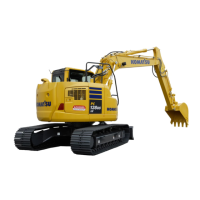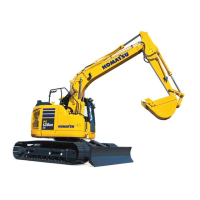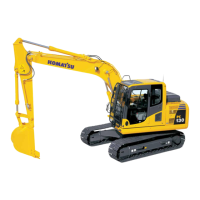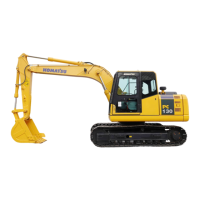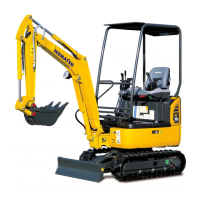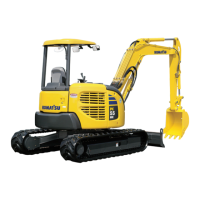MACHINE OPERATIONS AND CONTROLS
METHOD FOR OPERATIONS AND CHECKS AFTER STARTING ENGINE
• If there is any trouble such as emergency stop, abnor-
mal actuation, etc., turn the starting switch key to OFF
position.
• Do not perform operations nor operate the levers or
pedal abruptly while the hydraulic oil is at low temper-
ature. Always perform the warm-up operation for the
hydraulic equipment until the hydraulic oil tempera-
ture caution lamp displays the correct temperature.
When the hydraulic oil temperature is low, the low
temperature display shown in the figure is given.
• Display (A) when temperature is proper: Caution
lamp background (C) is blue.
• Display (B) when temperature is low: Caution lamp
background (C) is white.
• Perform the warm-up operation for the hydraulic com-
ponent thoroughly. The reaction of the machine to the
operation of the control levers and pedals are slow,
and the machine may not move as the operator in-
tends if the hydraulic component is not warm enough.
Particularly in a cold weather, perform the warm-up
operation for the hydraulic component thoroughly.
• Keep away from the exhaust pipe while the engine is
running and immediately after stopping the engine.
Keep combustible materials away from the exhaust
pipe outlet.
There are 2 types of warm-up operation: warm-up of the engine and warm-up of the hydraulic component. In
addition, depending on the environment, the method of performing the warm-up operation may differ, so perform
the warm-up operation according to the descriptions given in the appropriate section.
The hydraulic component is not warmed by simply performing engine warm-up operation. Perform the warm-up
operations for the hydraulic component separately from that for the engine. Perform the warm-up operation for
the hydraulic component, so that the hydraulic oil is also warmed up and it circulates in all the control circuits.
METHOD FOR CHECKING STARTING CONDITION AND UNUSUAL NOISE OF
ENGINE
• When starting the engine, check that the engine causes no abnormal noise and that it starts up easily and
smoothly.
• Check that there is no abnormal noise when the engine is idling or when the engine speed rises slightly.
When there is an abnormal noise at the engine startup and if that condition continues, the engine may be
damaged. In that case, ask your Komatsu distributor to check the engine as soon as possible.
METHOD FOR CHECKING LOW-SPEED RUN AND ACCELERATION OF ENGINE
• When stopping the machine during the normal traveling operation, check that the engine does not hunt or
stop suddenly.
• Check that the engine speed rises smoothly when the fuel control dial is turned to High idle (MAX) position.
• Perform these checks in a safe place, watching out for danger in the surroundings.
• When the engine performs very badly at low idle and in the acceleration and if that condition continues,
it may damage the engine or confuse the operator's sense of driving or lower the braking efficiency,
and as a result lead to an unexpected accident. In that case, ask your Komatsu distributor to check the
engine as soon as possible.
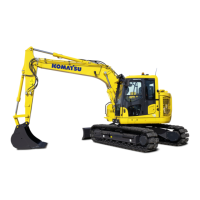
